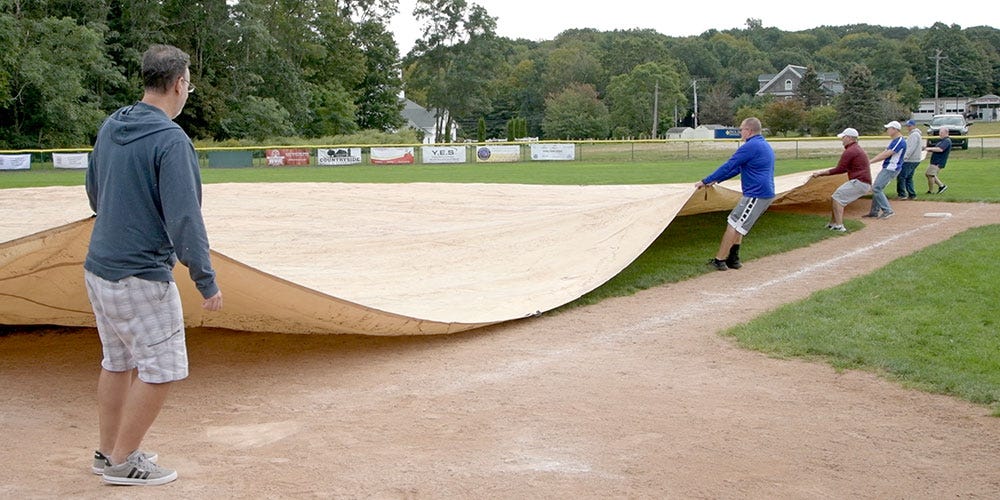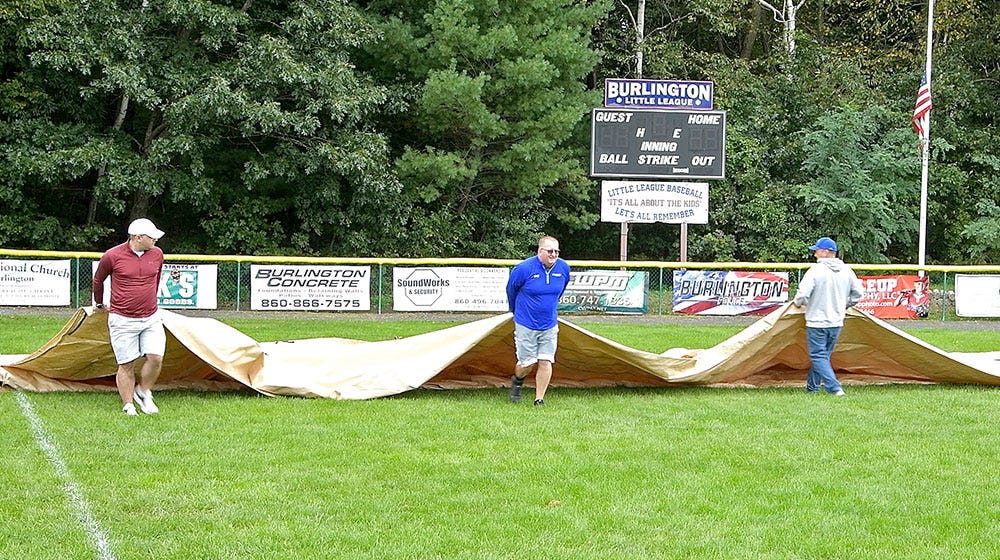It's easy to be fooled by the well-managed, highly trained ground crew as they skillfully, and in synchronized fashion, roll out and deploy a huge baseball field tarp over the infield in less than 5 minutes! Unfortunately for those who aren't trained professionals, it's a little bit of a different story.
Setting up a baseball field tarp is a complex, meticulous procedure that must be fully understood to implement. Unpreparedness can cause damage to the field that you're trying to protect, the tarp itself, and sometimes even the crew members.
To avoid the risk of any level of damage, you must learn the steps and critical instructions of handling a baseball field tarp that will enable you to participate in this important task confidently.


Why a Baseball Field Tarp is Important
We all know the uncertainties of the weather are always considered when planning season games. Field damage is common throughout season-long campaigns and during training days.
Daily maintenance is necessary to ensure that the field can withstand the constant activity of the athletes and their cleats and natural elements like extreme sun, rain, and snow. The decision to play on a too wet field is the number one cause of field damage.
It is also one of the top reasons for player injuries. The slippery mud surface that forms due to heavy rain flow is hazardous and does not support proper gameplay. Investing in an appropriate tarp is necessary to preserve the integrity of the field, and ultimately the game.
Rolling Out the Tarp
The first step in setting up a field tarp is rolling it out onto the portion of the field that is to be covered. The ground crew members typically use a tarp roller to unroll the tarp.
Professional baseball fields typically require a 170' x 170' full infield tarp, softball fields a 110' x 110' full infield tarp, and Little League fields a 100' x 100' full infield tarp. These are all standard sizes and can be subject to differences depending on the field and the tarp type.
The process of rolling out a full infield tarp will require between 6 to 12 crew members for a Professional Baseball field without water. With water, between 15-20 men are needed to pull a full infield tarp onto a Professional Baseball field.
During the process of rolling out and setting up the tarp, clear communication between the ground crew members and the crew chief is of extreme importance. Heavy rain and harsh winds can cause difficulty in communication between crew members and the field team leaders.
The use of a supported radio, or in extreme cases, the PA system, is the solution to this problem.


Unfolding the Tarp
The first major rule of setting a field tarp is to ensure that the ground crew understands what windward and leeward mean. Windward refers to the upwind side of the cover, while leeward refers to the downwind side.
In most cases, problems arise on the windward side where the wind must be kept from getting under it and blowing up the field cover. That's where you'll want to place the most experienced crew members.
Once the windward side is properly covered, the leeward side will ripple; however, the wind will not get beneath the cover. During the unfolding of the tarp, more crew members will be needed on the more dominant Windward side than on the Leeward side.
While rolling and unfolding the tarp, the goal is to keep as little wind from getting underneath the tarp as possible. One of the best ways to achieve this is to keep it as low to the ground as possible. Big waves of air from underneath the cover most commonly overpower ground crews.
If the wind starts to take the tarp away and you have a hold on it that wants to pull you, and you cannot control it, let it go. Do not risk a shoulder separation or any other severe injuries that could occur from aimlessly holding on. If you let go, the wind will quickly escape the wave it had created and deflate the tarp.
Laying Out the Tarp
After the tarp is successfully unfolded and moved into position, it should be quite a short time before the corners and edges of the tarp are anchored down. There are various ways to do this, the most common being with the use of sandbags or tarp pins.
Sandbags are not recommended due to the fact that they break down over time when overly exposed to the sun, causing the sand to fall out of the bottom. Instead, tarp pins are preferred because several of them can be carried in-hand.
This is a great benefit under extremely windy conditions and time sensitive situations. Tarp pins, which can be anchored 12 plus inches into the ground are far safer than just using random field equipment, and far more reliable in the harshest of conditions.


Folding the Tarp
Once the heavy rains and harsh winds have subsided, the ground crew will immediately rush back to the field to unanchor the tarp and begin folding it. This needs to be done quickly so that no more time is wasted and the players can continue.
When ready to fold, stretch out the tarp to rid it of any wrinkles. You'll want to start by folding the tarp in half and continue to fold it systematically until it is ready to roll onto the tarp roller. Note that you should not try to move the cover if a significant amount of water is sitting on top of it.
If the tarp is wet, pumping air into it while pulling the fold-over should rid you of that. Another option could be to use a soft roller to remove the excess water.
Rolling the Tarp Back Up
Once you have folded the tarp as many times as is necessary, and have it fit the tarp roller, roll the tarp roller down the length of the folded tarp to release the air trapped inside it. This will help reduce the drag as you roll the tarp onto the roller.
Lastly, line the tarp roller up with the folded tarp and roll upwards, ensuring that the roll is as straight and tight as possible. Note that the longer the tarp roller, the less you have to fold it.
And the less you fold a field tarp, the less drag you are creating from trapped air in the folds, thus making it easier to roll up in a future time. A tarp cover is also beneficial for keeping the harsh sun from breaking down the material exposed to.
Save Game Time with a Baseball Field Tarp
A field tarp is one of the best tools to ensure that the infield maintains its integrity, usability, and beauty. Though, as you have now learned, it is more complex than it is made out to seem. However the process can still be successful when handled by well-trained professionals. They should also be aware of the many risks and can think fast in the harsh and constantly changing conditions. Regardless of their role, everyone involved in the sport must be educated on how the different systems that make up the game work.





